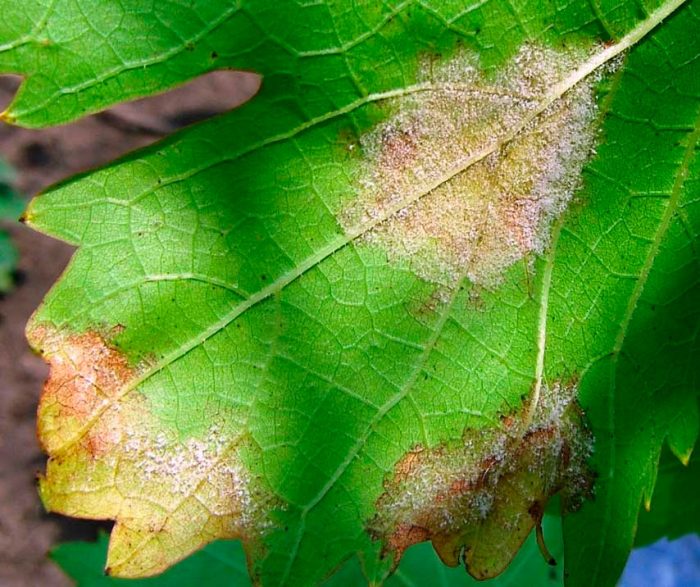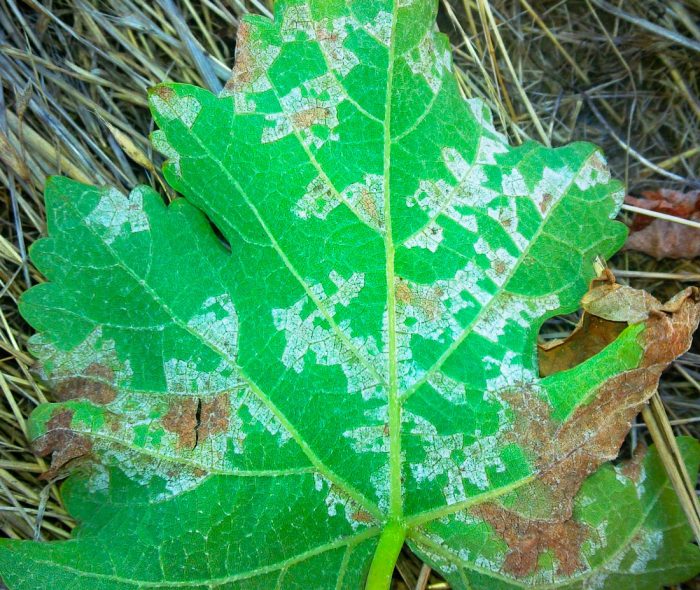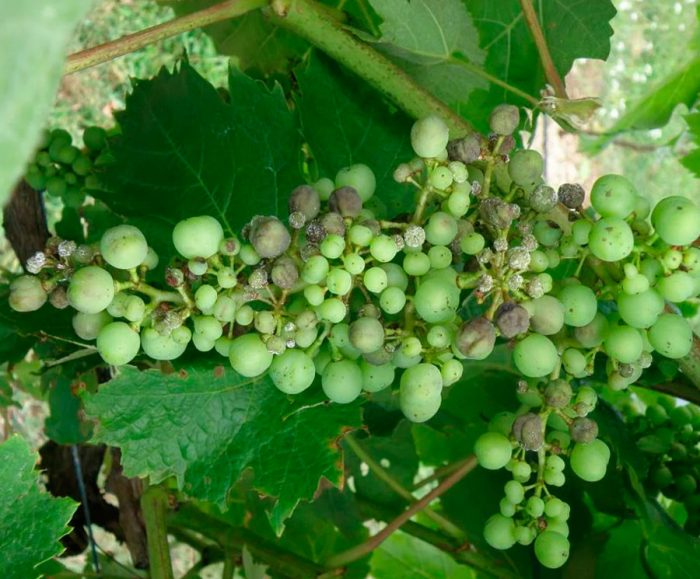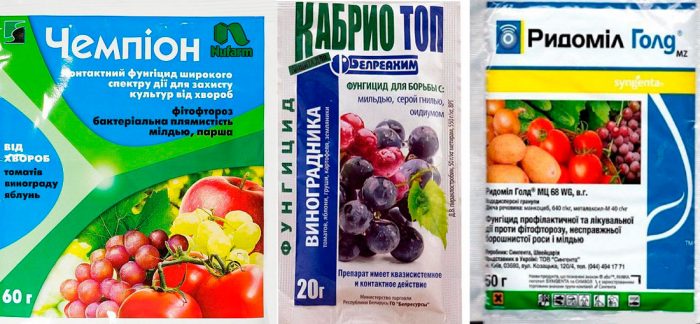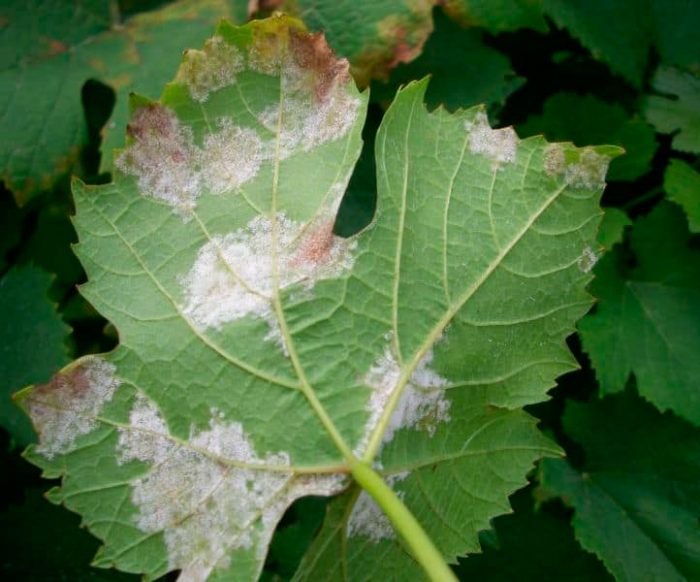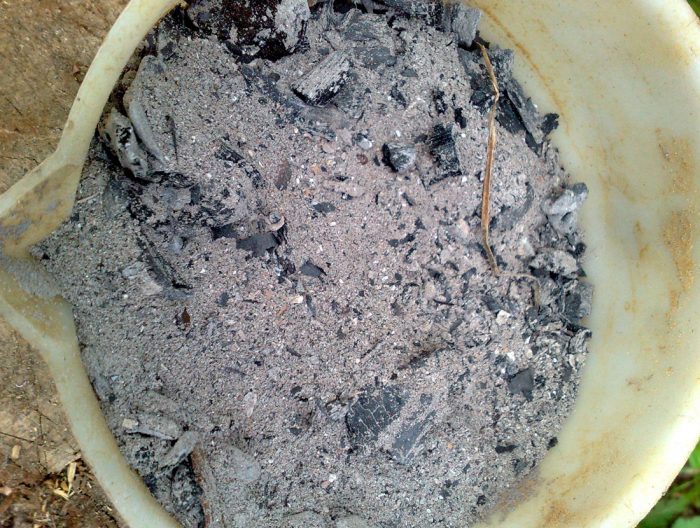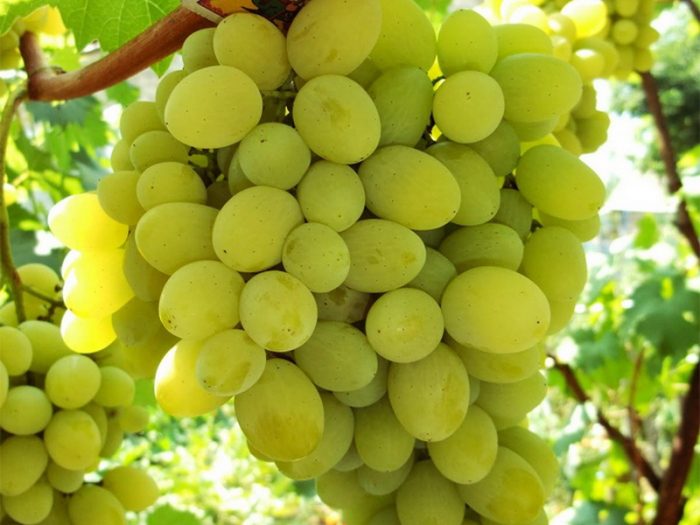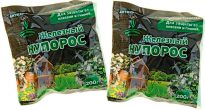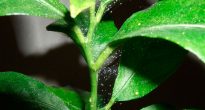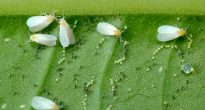Mildew disease (mildew), or downy mildew of grapes, is considered the most common and dangerous for European varieties of culture. All parts of the grape bush located above the ground are affected by this disease. Mildew begins to develop due to the pathogenic fungus - plasmapar vitikol. It was brought to France from North America, and it happened in 1878. After some time, this pathogenic fungus could already be found in all European vineyards. It was because of this disease that the decline of European viticulture was observed in the late 19th and early 20th centuries.
Content
Features of the disease
You can understand that the grapes are affected by mildew by the light-colored spots that form on the foliage. For example, on young leaf plates, transparent oily specks of a pale yellow color appear, their size is no more than a medium-sized coin. In this case, angular spots are formed on old foliage, and most often they are located along the veins. A short time after the formation of spots under them, a white powdery fluff (mycelium) forms on the seamy surface of the plate. As the disease progresses, such spots are formed on all aerial parts of the grapes, colored green, namely: on the shoots, inflorescences, antennae, ridges and young fruits. Twisting and yellowing of diseased inflorescences is observed, and then they become brown and dry. The fruits turn blue over time, then darken and wrinkle. They become as if leathery, and they can no longer be used both for winemaking and for food. The affected foliage begins to fly around ahead of time, and the tops of diseased shoots dry up.
The rate of development of the disease is greatly influenced by air temperature. For example, if the weather is warm (from 20 to 25 degrees), then the first symptoms of mildew can be detected 4–5 days after plant infection. If the weather is cooler, then the first signs of the disease can be detected a little later. The disease develops most actively in conditions of high air humidity. If you do not start a timely fight against mildew, you can lose up to half of the harvest.
Mildew or oidium
A great danger to grapes is not only mildew, but also powdery mildew. Due to this disease, the grower can lose up to 80 percent of the grape harvest. Unlike mildew, when a plant is affected by oidium, a whitish bloom appears on the surface of its foliage instead of oily specks.If you erase this plaque, then you can see specks of brown under it. Another feature of powdery mildew is that the plant affected by it begins to smell like rotten fish.
Mildew control measures
If European grape varieties grow on your site, then remember that they need mandatory regular preventive treatment for mildew. Most gardeners are struggling with downy mildew of grapes with special chemicals, but it will not be possible to protect the bushes from the disease without taking preventive measures into account, and the plants must be provided with good and proper care.
If, when planting bushes between them, maintain such a distance so that they are spacious, then thanks to this, the plants will be well ventilated and dry very quickly, and this contributes to a significant reduction in the risk of affecting them with such a fungal disease as mildew. It is also important to cut off excess stems and stepchildren in time, carry out a garter of growths and systematically pull out weeds.
Treatment
To cure vines affected by mildew, they should be sprayed with a special preparation that includes copper. Please note that there are remedies that work for quite a long time (about 20 days), but there are also medications that will wash off the bushes with the first rain. Most of the fungicidal agents in their composition include copper, it is considered the cheapest and most suitable substance for combating such a fungal disease. But it should be noted that some of the grape varieties react extremely negatively to products containing copper, especially during flowering. By what means can such grape varieties be processed? Today, a number of mildew control products called organic fungicides can be purchased in a specialty store. They do not contain copper, but they are also very effective in dealing with mildew and powdery mildew. These drugs are based on the following active substances: maneb, mancozeb, cinos, captan, cineb, tiram, etc. On the market, these funds are sold under various names.
Today it is possible to purchase such fungicidal preparations to combat downy mildew, which are a mixture of an organic fungicide and copper or sulfur (and sometimes both substances at once). Thanks to sulfur, it is possible to cope with the disease after the first treatment, and organic matter, together with copper, helps to mitigate the destructive effect of the latter on some grape varieties that are especially sensitive to copper.
If the bushes are very strongly affected by mildew, then in order to save them, the following systemic and contact means are used: Champion, Cabrio top, Ridomil Gold or Quadris.
Prevention measures
To protect grapes from mildew, one should not forget about preventive measures. The first time to process the bushes for prevention is necessary at the beginning of the spring period immediately after the vine is tied to the support. To begin with, they process the bushes, the surface of the earth under them and between the rows. And then, in order to prevent the spread of the disease, the surface of the site is covered with a layer of mulch. For prophylactic purposes, the bushes are treated with a solution of Oxychoma, Bordeaux liquid, Abiga peak or other means that are prepared in accordance with the instructions on the package.
The second time, in order to prevent, the plants are sprayed during the formation of 4–6 leaf plates. Since Bordeaux liquid helps to suppress the development of young growth, it is highly undesirable to use it for the second treatment. For processing, use the tool Polycarbacin or Polychom.In a bucket of ready-made working solution, which is made exactly according to the instructions, it is recommended to pour from 80 to 90 grams of colloidal sulfur, because it can provide reliable protection to plants from both mildew and oidium, and from ticks. In addition, sulfur helps to stimulate the formation of new leaf plates.
Shortly before the grape bushes bloom, they are sprayed with a solution of one of the following: Topaz, Tiovit Jet or Aktelik. After the formed fruits on the bushes are the size of medium-sized peas, they and the surface of the soil around them are treated with a solution of a contact-systemic agent, for example: Ridomil Gold, Thanos, Acrobat and others of a similar action. Experts recommend that it is imperative to resort to alternating fungicidal drugs, if this is not done, then the pathogenic fungus may develop resistance (addiction to the drug). In this regard, any of the means used to control or to prevent mildew can be used no more than once during one season for treatment.
During the leaf fall, the grape bushes are pruned. Then all the cut branches and stems, as well as the loose leaves, are collected and destroyed by fire. Before covering the grape bushes for wintering, they and the surface of the soil around them are sprayed with a solution consisting of 1 bucket of water and 200 grams of urea or 1 kilogram of salt.
Mildew preparations (fungicides)
There are many fungicides that are used to combat mildew, but the following are the most commonly used:
- Abiga Peak... It is a broad spectrum contact agent containing copper. It is used in the fight against bacterial and fungal diseases, while it can process industrial, decorative, vegetable, fruit and flower crops. The product is moderately hazardous.
- Acrobat MC... Such a systemic-local remedy perfectly copes with grape mildew, late blight and alternaria of potatoes, as well as with peronosporosis of cucumbers. The substance is very toxic to humans.
- Bordeaux liquid... Such a broad spectrum fungicidal preparation is able to protect berry, melon, flower, vegetable, fruit, citrus and ornamental crops from a whole range of diseases. The substance is very dangerous for humans.
- Copper sulfate... Broad-spectrum contact agent containing copper. It is used in the fight against various diseases of fruit, ornamental, berry crops and shrubs. This substance is moderately hazardous.
- Oxyhom... Systemic contact drug with a wide spectrum of action effectively fights against fungi of the oomycete class. The substance is highly toxic.
- Ridomil Gold... This systemic contact agent is used in the fight against various fungal diseases, for example, mildew, late blight and Alternaria. The substance is very dangerous.
- Quadris... Such a broad-spectrum agent effectively protects cucumbers (in open ground and greenhouses), onions, grapes, tomatoes, potatoes and sports lawns from a complex of diseases. The substance is highly toxic.
- Convertible top. Combined broad spectrum fungicide specially formulated to protect grapes from both mildew and mildew. The substance is moderately hazardous.
- Tiram... A contact pesticidal agent that effectively protects crops from phytopathogenic fungi. Funds made on the basis of Thiram belong to the second and third classes of danger to humans.
- Polychom... A fungicidal preparation with a complex action, it is used to protect crops from the following fungal diseases: mildew (peronosporosis), moniliosis, late blight, etc. Moderately dangerous for humans.
- Polycarbacin... A systemic fungicidal agent with a curative and protective effect. It is used in the fight against fungal diseases of fruit and vegetable plants. Differs in moderate danger.
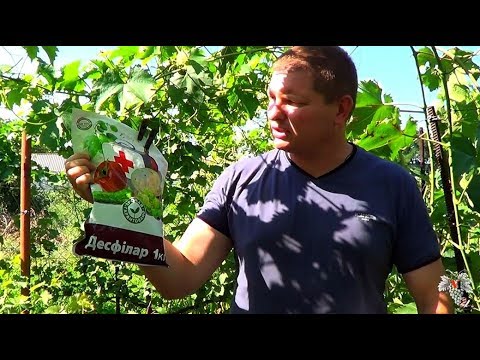

Watch this video on YouTube
Folk remedies
In the event that you managed to detect the symptoms of mildew development on grapes at an early stage, then you can try to save the plants and the crop with folk remedies that are not as aggressive and toxic as pesticidal and fungicidal preparations. Effective folk remedies:
- 10 liters of water is combined with 1 liter of wood ash (pre-sifted), everything is mixed well. The infusion will be ready after 5 or 6 days. Dissolve 50 grams of household soap crushed on a grater in the strained product. This tool is sprayed on the bushes and the surface of the soil under them. This solution is most effective in the fight against mildew in the second half of the summer period, while it is recommended to carry out treatments regularly once every 1.5 weeks.
- Fill a glass with garlic cloves and grind them in a meat grinder, and then combine with 1 liter of water. Put the mixture in a dark place for 24 hours. Then the strained infusion is diluted with 6–7 liters of water and 50 grams of potassium permanganate is added to it (the composition should turn pink), iodized salt and liquid dishwashing detergent (laundry soap). The grapes will need two sprays every 15 days.
- Add 5 grams of potassium permanganate to a bucket of water. Treat the foliage on the bushes so that the bottom surface is moistened with the product. Then the front surface of the foliage is powdered with wood ash.
- If dill is grown near grapes, then this will be an excellent prevention of mildew on plants. But in this case, excessive growth of dill should not be allowed.
Mildew resistant grape varieties
Among the various grape varieties, there are those that are susceptible to mildew damage to a greater or lesser extent. If the variety is resistant to this disease, then this will significantly reduce the number of spraying of the bushes with chemicals, which has a positive effect on the quality of the fruit. This resistance is assessed by experts on a five-point scale of Gusfeld:
- 0 points - varieties are never affected by mildew, and therefore they do not need preventive treatments for this disease;
- 1 point - in such varieties, no more than 5 percent of the foliage is affected by mildew, therefore, in this case, there is no need for preventive treatments for mildew;
- 2 points - in these varieties, no more than 10 percent of the foliage is affected by the disease, so they also do not need protective spraying;
- 3 points - these varieties are distinguished by relative endurance, during the season they will need only 2 preventive treatments, since without them, with mildew damage, the gardener can lose up to 25% of the crop;
- 4 points - grape varieties are quite susceptible to mildew, during the season they must be treated for prevention 4 or 5 times, otherwise the gardener may lose up to half of the harvest;
- 5 points - these varieties are very susceptible to downy mildew, therefore, for the purpose of prevention, they are sprayed after each rain, if this is not done, then you can lose the entire crop.
Almost all Euro-Asian varieties are highly susceptible (5 points). But the relatively recent Euro-American varieties and other more complex hybrids are quite resistant to mildew (3 and 2 points).
The best grape varieties that are resistant to downy mildew are:
- Golden resistant... A high-yielding early table variety characterized by resistance to frost as well as powdery mildew, mildew and gray mold. Medium-sized fruits of white color have a golden hue on the sunny side. Their juicy pulp is distinguished by its harmonious fresh taste.
- Dniester pink... It is a productive frost-resistant late variety. The medium-sized dark pink fruit has a firm flesh with a regular flavor.
- Buffalo... This American variety is frost-resistant. Medium-sized oval fruits are colored black, have a rich strawberry taste and a tart aftertaste.
- Pineapple... This American variety is also frost and mildew resistant. Large greenish-yellow fruits are covered with thick skin, their slimy tasty pulp has a pineapple-like odor.
- Cardinal... This early Californian variety has large berries weighing 8 to 10 grams, they are very tasty and have a nutmeg smell.
- Mascot... An early-medium table high-yielding variety resistant to frost has large (12 to 16 grams) white fruits. Their taste is harmonious, and after full ripening, the berries have a nutmeg smell.
In addition to these grape varieties, varieties such as: Honey Gift, Zaporozhye Gift, Alex, Bazhena, Noble Muscat, Nistru, Original, etc. are resistant to downy mildew to varying degrees.


Watch this video on YouTube

